Complete Solutions to SECTION-II of chapter SAMPLE PAPER 2015 of Class 10 book with complete answers and questions
| Class 10 | BIOLOGY |
| Chapter | SAMPLE PAPER 2015 |
| GURUKUL | SECTION-II |
| Number Of Questions | 63 |
| Academic Year | 2023-24 |
The diagram below shows two test-tubes A and B. Test-tube A contains a green water plant. Test-tube B contains both a green water plant and a snail. Both Test-tubes are kept in sunlight. Answer the questions that follow :

Name the physiological process that releases the bubbles of oxygen.
View SolutionThe diagram below shows two test-tubes A and B. Test-tube A contains a green water plant Test-tube B contains both a green water plant and a snail. Both test tubes are kept in sunlight Answer the questions that follow
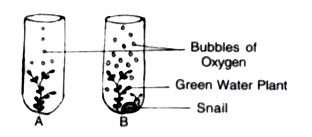
Explain the physiological process as mentioned above
View SolutionThe diagram below shows two test-tubes A and B. Test-tube A contains a green water plant Test-tube B contains both a green water plant and a snail. Both test tubes are kept in sunlight Answer the questions that follow

What is the purpose of keeping a snail in test-tube "B?
View SolutionThe diagram below shows two test-tubes A and B. Test-tube A contains a green water plant Test-tube B contains both a green water plant and a snail. Both test tubes are kept n sunlight Answer the questions that follow

Why does test-tube 'B' have more bubbles of oxygen
View SolutionThe diagram below shows two test-tubes A and B. Test-tube A contains a green water plant Test-tube B contains both a green water plant and a snail. Both test tubes are kept n sunlight Answer the questions that follow
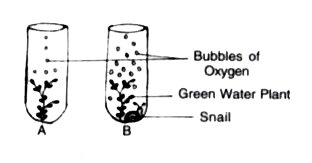
Give an example of a water plant that can be used in the above experiment.
View SolutionThe diagram below shows two test-tubes A and B. Test-tube A contains a green water plant Test-tube B contains both a green water plant and a snail. Both test tubes are kept in sunlight Answer the questions that follow

Write the overall chemical reaction for the above process.
View SolutionGive the biological/technical term for the following:
A mixture of smoke and fog.
View SolutionGive the biological/technical terms for the following:
Capacity of our body to resist diseases.
View SolutionGive the biological/technical terms for the following:
Fixing of developing zygote on the uterine wall.
View SolutionGive the biological/technical terms for the following:
The permanent stoppage of menstruation at about the age of 45 years in a female.
View SolutionReabsorption of water from distal parts of the tubules is facilitated by hormone ________.
View SolutionGive technical term to the following:
A thin membrane covering the entire front part of the eye.
View SolutionGive technical term to the following:
Eye lens losing flexibility resulting in a kind of long-sightedness in elderly people.
View SolutionGive technical term for the following:
The number of persons living per square kilometre at any given time.
View SolutionGive biological technical terms for the following
The sound produced when the atrioventricular valves close the heart.
View SolutionThe process by which a white blood cell or an amoeba engulfs bacteria is called phagocytosis.
View SolutionGiven below is an apparatus which was setup to investigate a physiological process in plants. The setup was placed in bright sunlight. Answer the questions that follow:
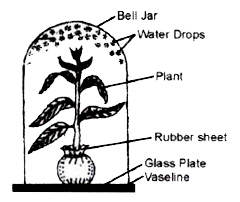
Name the process being studied. Define the process.
View SolutionGiven below is an apparatus which was setup to investigate a physiological process in plants. The setup was placed in bright sunlight. Answer the questions that follow:

Why was the pot enclosed in a rubber sheet ?
View SolutionGiven below is an experimental set-up to study a particular process:

Why is the pot covered with a plastic sheet ?
View SolutionGiven below is an experimental set-up to study a particular process:

Suggest a suitable control for this experiment.
View SolutionGiven below is an experimental set-up to study a particular process:

Mention one way in which this process is beneficial to the plant.
View SolutionGiven below is an apparatus which was setup to investigate a physiological process in plants. The setup was placed in bright sunlight. Answer the questions that follow:

List two adaptations in plants to reduce the above process.
View SolutionAnswer the following questions briefly.
List two reasons for the population explosion in India.
View SolutionGive two functions of the amniotic fluid.
View SolutionTell the functions of ear ossicles.
View SolutionList any two activities of WHO.
View SolutionState Mendel's Law of Dominance.
View SolutionThe figures given below are cross-sections of blood vessels

Identity the blood vessels A B and C.
View SolutionThe figures given below are cross-sections of blood vessels

Name the parts labelled 1 – 4.
View SolutionThe figures given below are cross-sections of blood vessels

Name the type of blood that flows (a) through A. (B) through b
View SolutionThe figures given below are cross-sections of blood vessels

Venlion two structural differences between A and b
View SolutionThe figures given below are cross-sections of blood vessels

In which of the above vessels referred in the above diagram exchange of gases actually take place?
View SolutionDifferentiate between the following:
Diffusion and osmosis
View SolutionDifferentiate between the following pairs on the basis of what is mentioned within brackets :
RBC and WBC (Shape)
View SolutionDifferentiate between the following pair on the basis of what is mentioned within bracket.
vasectomy and Tubectomy (Explain)
View SolutionDifferentiate between the following:
Vasopressin and Insulin (Deficiency disorder)
View SolutionGive one difference between the following pairs on the basis of what is given in brackets :
Rods and Cones (Pigment present)
View SolutionThe diagram given below shows a section of a human kidney. Study the diagram carefully and answer the questions that follow :
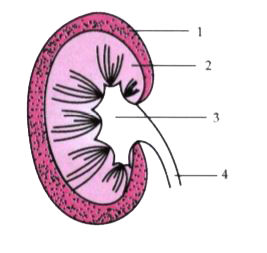
Label the parts numbered 1 to 4.
View SolutionThe diagram given below shows a section of a human kidney. Study the diagram carefully and answer the questions that follow:

(i) Label the parts numbered 1 to 4.
(ii) Why does part "2" have a striped appearance?
(iii)What is the fluid that passes down part:'4' ? Name the main nitrogenous waste present in it.
(iv) Mention the structural and functional unit of kidneys.
(v) Name the two major steps in the formation of the fluid mentioned
View SolutionThe diagram given below shows a section of a human kidney. Study the diagram carefully and answer the questions that follow:

(i) Label the parts numbered 1 to 4.
(ii) Why does part "2" have a striped appearance?
(iii)What is the fluid that passes down part:'4' ? Name the main nitrogenous waste present in it.
(iv) Mention the structural and functional unit of kidneys.
(v) Name the two major steps in the formation of the fluid mentioned
View SolutionGiven below is a simple diagram of the human kidney cut open longitudinally. Answer the following questions :

Name the structural and functional units of the kidney.
View SolutionThe diagram given below shows a section of a human kidney. Study the diagram carefully and answer the questions that follow:

(i) Label the parts numbered 1 to 4.
(ii) Why does part "2" have a striped appearance?
(iii)What is the fluid that passes down part:'4' ? Name the main nitrogenous waste present in it.
(iv) Mention the structural and functional unit of kidneys.
(v) Name the two major steps in the formation of the fluid mentioned
View SolutionDraw neat and labelled diagrams of the Malpighian Capsule.
View SolutionDraw neat and labelled diagrams of the A Myelinated Neuron.
View SolutionThe diagram given below shows the male urinogenital system of a human being. Study the diagram and answer the questions that follow :
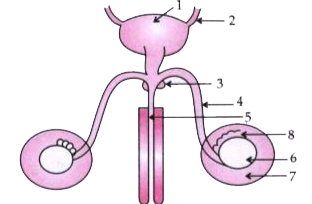
Label the parts numbered 1 to 8.
View SolutionThe diagram given below shows the male urinogenital system of a human being. Study the diagram and answer the questions that follow :

Name the corresponding structure of part (4) in female reproductive system.
View SolutionThe diagram given below shows the male urinogenital system of a human being. Study the diagram and answer the questions that follow :

What is the role of part 7 ?
View SolutionIn a homozygous plant round seeds (R) are dominant over wrinkled seeds (r):
Draw a Punnett square to show the gametes and offspring when both the plants have heterozygous round seeds (Rr).
View SolutionIn a homozygous plant round seeds (R) are dominant over wrinkled seeds (r):
Mention the Phenotype and Genotype ratios of the offspring in `F_2` generation.
View SolutionIn a homozygous plant round seeds (R) are dominant over wrinkled seeds (r):
Name the sex chromosomes in human males and females.
View SolutionIn a homozygous plant round seeds (R) are dominant over wrinkled seeds (r):
Briefly explain the term 'Mutation'.
View SolutionIn a homozygous plant round seeds (R) are dominant over wrinkled seeds (r):
What is the number of chromosomes in the gametes of human beings?
View SolutionThe diagram given below represents the human heart in one phase of its functional activities. Study the same and answer the questions that follow :

Name the phase.
View SolutionThe diagram given below represents the human heart in one phase of its functional activities. Study the same and answer the questions that follow :
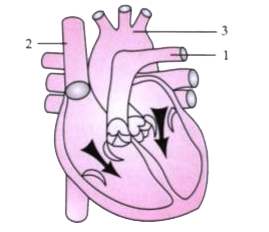
Which part of the heart is contracting in this phase ? Give a reason to support your answer
View SolutionThe diagram given below represents the human heart in one phase of its functional activities. Study the same and answer the questions that follow :

Label the parts 1, 2 and 3.
View SolutionThe diagram given below represents the human heart in one phase of its functional activities. Study the same and answer the questions that follow :

Which part of the heart is contracting in this phase ? Give a reason to support your answer
View SolutionThe diagram given below represents the human heart in one phase of its functional activities. Study the same and answer the questions that follow :

Which part of the heart is contracting in this phase ? Give a reason to support your answer
View SolutionThe diagram given below represents the human heart in one phase of its functional activities. Study the same and answer the questions that follow :

Name the phase.
View SolutionExplain how does green house effect cause global warming ?
View SolutionThe pressure exerted by the cell wall to balance the turgor pressure is called .............. pressure.
View SolutionDescribe in brief : Selective reabsorption
View SolutionExplain the following terms:
(a) Environmental resistance
(b) Natality rate
(c) Exponential phase
View SolutionExplain briefly :
Pulse.
View Solution
SECTION-II questions and complete solutions for chapter SAMPLE PAPER 2015 of EVERGREEN BIOLOGY (ENGLISH) of Class 10